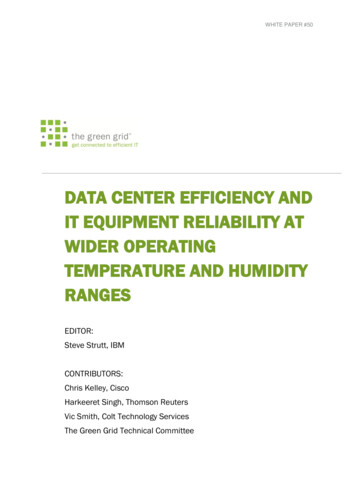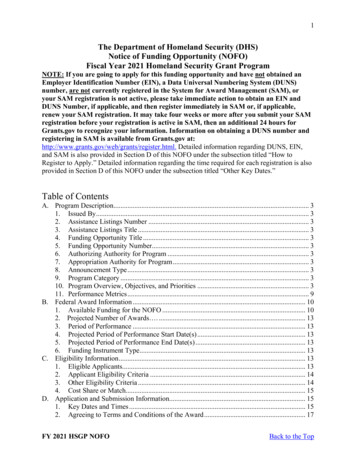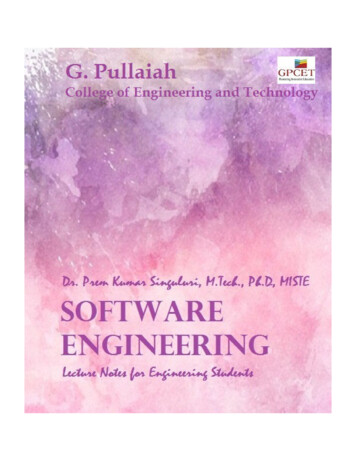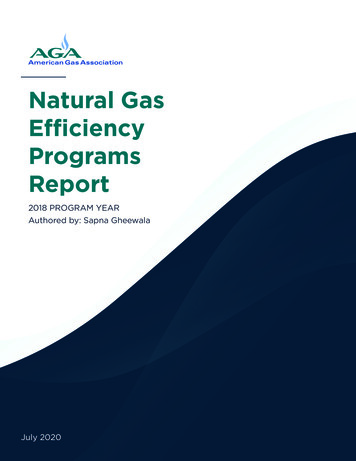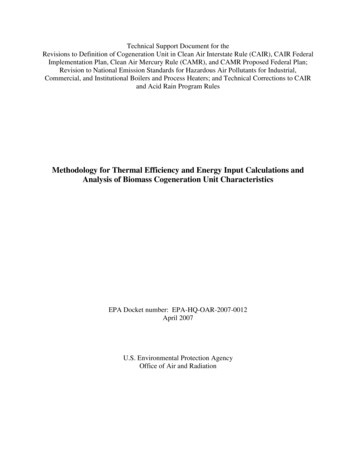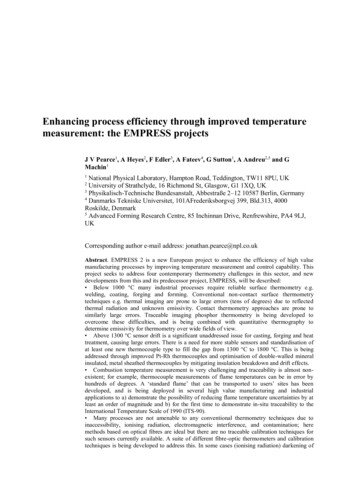
Transcription
Enhancing process efficiency through improved temperaturemeasurement: the EMPRESS projectsJ V Pearce1, A Heyes2, F Edler3, A Fateev4, G Sutton1, A Andreu2,5 and GMachin11National Physical Laboratory, Hampton Road, Teddington, TW11 8PU, UKUniversity of Strathclyde, 16 Richmond St, Glasgow, G1 1XQ, UK3Physikalisch-Technische Bundesanstalt, Abbestraße 2–12 10587 Berlin, Germany4Danmarks Tekniske Universitet, 101AFrederiksborgvej 399, Bld.313, 4000Roskilde, Denmark5Advanced Forming Research Centre, 85 Inchinnan Drive, Renfrewshire, PA4 9LJ,UK2Corresponding author e-mail address: jonathan.pearce@npl.co.ukAbstract. EMPRESS 2 is a new European project to enhance the efficiency of high valuemanufacturing processes by improving temperature measurement and control capability. Thisproject seeks to address four contemporary thermometry challenges in this sector, and newdevelopments from this and its predecessor project, EMPRESS, will be described: Below 1000 C many industrial processes require reliable surface thermometry e.g.welding, coating, forging and forming. Conventional non-contact surface thermometrytechniques e.g. thermal imaging are prone to large errors (tens of degrees) due to reflectedthermal radiation and unknown emissivity. Contact thermometry approaches are prone tosimilarly large errors. Traceable imaging phosphor thermometry is being developed toovercome these difficulties, and is being combined with quantitative thermography todetermine emissivity for thermometry over wide fields of view. Above 1300 C sensor drift is a significant unaddressed issue for casting, forging and heattreatment, causing large errors. There is a need for more stable sensors and standardisation ofat least one new thermocouple type to fill the gap from 1300 C to 1800 C. This is beingaddressed through improved Pt-Rh thermocouples and optimisation of double-walled mineralinsulated, metal sheathed thermocouples by mitigating insulation breakdown and drift effects. Combustion temperature measurement is very challenging and traceability is almost nonexistent; for example, thermocouple measurements of flame temperatures can be in error byhundreds of degrees. A ‘standard flame’ that can be transported to users’ sites has beendeveloped, and is being deployed in several high value manufacturing and industrialapplications to a) demonstrate the possibility of reducing flame temperature uncertainties by atleast an order of magnitude and b) for the first time to demonstrate in-situ traceability to theInternational Temperature Scale of 1990 (ITS-90). Many processes are not amenable to any conventional thermometry techniques due toinaccessibility, ionising radiation, electromagnetic interference, and contamination; heremethods based on optical fibres are ideal but there are no traceable calibration techniques forsuch sensors currently available. A suite of different fibre-optic thermometers and calibrationtechniques is being developed to address this. In some cases (ionising radiation) darkening of
the fibre is a problem, and this is being overcome by the development of novel thermometryapproaches based on practical ‘hollow core’ fibres.1. IntroductionManufacturing in the EU currently accounts for about 40 % of EU exports, and the lion’s share ofcompany R&D takes place in high value manufacturing [1]. However, the proportion ofmanufacturing has been in decline as services account for an increasing share of exports. The EU hasstrategic ambitions to restore a sustainable level of manufacturing and achieve or retain globalleadership in sectors such as automotive, aeronautics, engineering, space, chemicals andpharmaceutical industries [2]. EU companies cannot compete on low price, low quality products. Theymust turn to innovation and productivity, energy and resource efficiency (and minimising waste), andhigh value-added to compete in global markets [3]. In practical terms this means enhancing efficiency– that is, energy efficiency and improved product consistency, which are strongly correlated – inindustrial processes, which means improving process control, i.e. temperature measurement.There is a practical imperative for European organisations: the EU’s climate and energy packagemandates a 20 % increase in energy efficiency across Europe by 2020 [4]. This is considered a GrandChallenge in EURAMET’s Strategic Research Agenda for Metrology in Europe 2016 [5], which alsoidentified the improvement of the efficiency of power generation and other industrial processesthrough improved metrology of critical monitoring and control parameters as a research priority [5].Improved in-situ monitoring and control for enhancing process efficiency through improvedinstrumentation is identified in [5] as a key outcome. All energy efficiency gains are accompanied by acorresponding reduction in carbon emissions [6]. An energy efficiency improvement target of 20 % isalso the aim of the European Directive 2012/27EU [7] on energy efficiency, which has recently beenupdated with an even more ambitious target of 30 % by 2030 in COM(2016) 860 [8] with a proposalfor legislation in COM(2016) 761 [9]. This signals the intent of the EU to bring energy efficiency tothe forefront of its strategy. The target of 30 % looks set to be formalised by a revision to Directive2012/27/EU [9].There are a number of key challenges in high value manufacturing associated with improvingefficiency (i.e. both energy efficiency and improved productivity) and reducing greenhouse gasemissions. Surface temperature measurement is a common challenge in advanced manufacturing.Measurement of the temperature of billets during forming, forging and heat treatment up to 1000 Cremains problematic because contact probes cannot be inserted or placed in contact with the surfacedue to contamination and heat flow effects (which cause errors). Non-contact thermometry methodsare beset by the problem of unknown emissivity and reflected thermal radiation. Heat treatment ofsteel structures before and after welding is a critical part of large scale manufacturing, and a rapid,practical means of measuring the surface temperature is urgently needed due to the very high rejectionrates and poor product consistency associated with existing methodologies. Measurement of thesurface temperature of rapidly moving parts e.g. automotive brake disks, which can reach up to 1000 C, remains challenging due to the difficulty of ensuring that conventional contact probes are inadequate thermal contact with the surface. The use of phosphors has facilitated improvements in thisarea because they are effectively a coating which is in almost perfect thermal contact with the surfaceand it is non-perturbative, but they provide only a point measurement; what is really needed is animaging technique to provide information on the spatial temperature distribution. Here traceable 2Dphosphor thermometry will be developed, both with scanning techniques and by combination withquantitative thermography to solve the emissivity problem with conventional radiance basedthermometry approaches.The imminent introduction of a new double-walled MI thermocouple by UCAM and CCPI [10]will result in the commercial availability of a new ultra-stable thermocouple for use up to 1300 C.However, the new double-walled format makes it challenging to meet the dimensional requirementsset out in IEC 61515 [11] because the thicker protective outer wall reduces the amount of space insideleading to the thermocouple wires having a smaller diameter which in many cases falls below the
minimum permitted by the standard. Similar limitations apply to industry standards such as AMS2750E [12] (heavily used in aerospace manufacturing), which may limit uptake. Drift tests of the newthermocouples alongside conventional MI thermocouples are required to provide the documentaryevidence needed to revise IEC 61515. To maximise the benefits to end users, further optimisation isrequired, in particular the optimisation of the ratio of the two outer wall thicknesses. Furthermore, nowthat these sensors exhibit substantially improved stability up to 1300 C, a new measurement error hasappeared, due to the decreased resistance of the insulating ceramic material between the thermocouplewires [13]. Also above about 1000 C Pt-Rh thermocouples are increasingly widely used. InEMPRESS a systematic investigation identified the Pt-40%Rh vs. Pt-6%Rh thermocouple as beingoptimal in terms of stability; and a series of measurements are required to progress the standardisationof these developments. Essential underpinning standardisation measurements are needed.Fire resistance testing and standardisation in aerospace applications remains a significant issue dueto the extreme difficulty of measuring reliable and traceable flame temperatures; this generallyrequires the two dimensional measurement of flame temperature. Flame and combustion temperaturein R&D production settings is often performed with sophisticated laser diagnostic apparatus; but,despite the sophistication, temperature uncertainties are typically of the order of 10 % and are nottraceable. Measurements are often used to validate combustion models; more accurate modellingrequires better measurements. A number of European companies are developing combined heat andpower (CHP) plants and waste incinerators for both domestic and industrial use; widespread uptake ofCHP is identified as a priority by the European Commission [14]. For small electricity/heat productionunits such as, for example, waste incinerators and/or district power plants, selective non-catalyticreduction (SNCR) technology is commonly used to reduce NOx emissions at around 1000 C. A 2Dtemperature profile measurement of the combustion process will enable better control of thetemperature in the NOx SNRC process, to optimise NOx reduction and consumption of NH3/NH4OH.A portable standard flame is needed to introduce traceability, to improve process control accuracy, andto enhance efficiency.There are many processes (e.g. brake pad production/testing, forging) which strongly depend ontemperature and which are not amenable to monitoring with conventional sensors such asthermocouples (contamination/transmutation/electromagnetic fields) or thermography (unknownemissivity/no line-of-sight). Examples include plasma-based processes, silicon processing, ionisingradiation, particularly the gamma rays used for radiotracers or weld inspection, and high temperatureindustrial furnaces e.g. induction furnaces. Fibre-optic thermometers have become widespread sincetheir inception in the 1960s, but few, if any, currently offer the possibility of traceable measurements.Different types of fibre-optic thermometers need to be developed offering immunity to different typesof harsh environment, including point sensors and distributed sensors. Development of each type ofsensor needs to be accompanied by the development of a traceable calibration methodology, and an insitu demonstration in process environments in order to demonstrate the utility of the new metrologicalframework for fibre-optic thermometry.This paper is laid out as follows. Firstly the EMPRESS2 consortium is introduced with adescription of the partners’ activities and synergies. The technical activities are then summarised, withfour work packages devoted to phosphor thermometry, thermocouples, combustion thermometry andfibre optic thermometry respectively. The paper concludes with a brief summary.2. The consortiumThe consortium comprises 26 partners across Europe including 9 NMIs, 2 DIs, 4 universities, 2research institutes, and 9 companies. The partners are summarised in Table 1; this also shows thestrong complementarity of the specialisms.
ParticipantTypeShort NameOrganisation legal full nameCountrySpecialismNMI, ProjectCoordinatorNPLNational Physical LaboratoryUnitedKingdomThermocouples, fibre optics,phosphor, combustionNMICEMCentro Español de MetrologíaSpainThermocouplesNMICMIČeský Metrologický Institut BrnoCzech RepublicThermocouplesNMIDTITeknologisk InstitutDenmarkSurface temperatureNMIINRIMIstituto Nazionale di RicercaMetrologicaItalyPhosphor thermometryNMIJVJustervesenetNorwayOptics, altGermanyThermocouples, photonicsNMITUBITAKTurkiye Bilimsel ve TeknolojikArastirma KurumuTurkeyThermocouplesNMIULUniverza v LjubljaniSloveniaThermocouplesDICSICAgencia Estatal Consejo Superior deInvestigaciones CientificasSpainOptical fibre thermometryDIDTUDanmarks Tekniske UniversitetDenmarkIR & UV spectroscopyResearchinstituteCNRConsiglio Nazionale delle -Institut für PhotonischeTechnologien eVGermanyFibre optics, lasersCompanyElkemElkem ASNorwaySilicon processingCompanyITTITTItalyBraking systemsCompanyMUTMUT Advanced Heating GmbHGermanyFurnace manufacturingCompanyACERINOXAcerinox SASpainSteel manufacturingCompanyBAEBAE Systems Marine LimitedUnitedKingdomShipbuildingCompanyB&W VolundBabcock & Wilcox Vølund A/SDenmarkWaste incinerationCompanyCCPICCPI Europe LtdUnitedKingdomThermocouplesCompanyJMJohnson MattheyUnitedKingdomPrecious metalsCompanySensiaSensia SolutionsSpainIR imaging devicesUniversityUoSUniversity of SouthamptonUnitedKingdomHollow core fibresUniversitySTRATHUniversity of Strathclyde (includesAdvanced Forming Research Centre,AFRC)UnitedKingdomPhosphor thermometry &forming/forgingUniversityUC3MUniversidad Carlos III de MadridSpainOptics & IR instrumentsUniversityUCAMThe Chancellor, Masters and Scholarsof the University of CambridgeUnitedKingdomThermocouplesTable 1. Project partners and their associated specialisms.
ActivityParticipantSpecialismPhosphor thermometry(decay-time)INRIMPhosphor thermometry developmentCNRTribologyITTManufacture of braking systemsNPLPhosphor thermometry development, traceable calibrationtechniquesSTRATHPhosphor thermometry developmentDTIPhosphor thermometry developmentBAEProvide access to marine manufacturing for trialsCMI, TUBITAK, UL, NPL, PTB,CEM, DTITraceable calibration facilitiesJM, CCPI, UCAMSupply of thermocouple wireNPLSupply, calibrate portable standard flameDTUDevelopment of IR, UV spectroscopy in-situ/on-linemeasurement techniquesB&W VOLUNDProvide access to waste incineration facilities for trialsSENSIADevelopment of commercial IR imaging devicesUC3MDevelopment of optics and IR instrumentationIPHTDevelopment of laser and fibre optic techniquesJVDevelopment of sapphire based sensors; traceable calibrationtechniquesPTBDevelopment of FBG fibre optic sensors; traceablecalibration techniquesMUTProvide access to industrial furnace manufacturing for trialsElkemProvide access to silicon processing for trialsFibre-opticthermometry (hollowcore/bundles)UoSOptical fibre development, instrumentationNPLDevelopment of traceable calibration esting and development of fibre optic sensorsACERINOXProvide access to stainless steel manufacturing for trialsCEMDevelopment of traceable calibration techniquesPhosphor thermometry(intensity Fibre-opticthermometry (hybridBB/FBG)Table 2. Grouping of specialisms to illustrate the collaborative activities.3. The work packagesGood progress was made in the first EMPRESS project [15,16], particularly in the development ofworking prototypes of several novel thermometers including the phosphor thermometer, several newtypes of ultra-stable thermocouples, a portable standard flame and a suite of flame and combustiontemperature diagnostic techniques. In particular, each of the key developments was tested in at leastone real-world setting. The activities are grouped into four work packages devoted to phosphorthermometry, thermocouples, combustion thermometry and fibre optic thermometry respectively.3.1. WP1: Accurate methods for phosphor thermometryIn the new project, EMPRESS2, phosphor thermometry will be further developed to facilitate reliablesurface temperature mapping for the first time, so that parts undergoing forging, forming, welding, orheat treatment can be monitored with respect to the entire surface rather than a point. Secondly, thetechnique will be combined with quantitative thermography to enable real-time determination of
emissivity, with a target uncertainty of better than 3 C up to 1000 C. Multiple partners, bringingcomplementary techniques, will enable validation of these techniques and implementation in-processin a suite of manufacturing environments.In EMPRESS, traceable phosphor thermometry was established on a routine basis, with thephosphor coating being applied to a surface and a spot measurement made with uncertainty of about 1 C. With this, surface temperatures up to 500 C can be performed. The concept is being takenforward in EMPRESS2 with three aims in mind, namely to extend to 1000 C, to extend to twodimensions, i.e. phosphor imaging, and to combine with quantitative thermography to enable in-situdetermination of emissivity.The aim of this activity is to develop, validate and test a suite of phosphor thermometry sensingtechniques for accurate and traceable surface temperature measurement. The outputs will be trialled inhigh-value manufacturing processes, such as welding, coating, forging and forming, to providetraceable surface temperature measurements. The systems will be developed for use up to 1000 C.There are three key types of phosphor thermometry systems to be developed, each with a specific typeof application in mind:1. The first is a 2D intensity ratio phosphor thermometer, employing a traceably calibratedphosphor. This will be combined with quantitative thermography, enabling the production ofemissivity maps.2. The second will be optimised for the coating of billets to enable both online monitoring ofbillet temperature over the entire piece during heat treatment, and ‘offline’ monitoringwhereby the phosphor records the temperature during the heat treatment for subsequentdetermination. The latter approach is useful when the billet cannot be viewed.3. The third is a fibre-optic system for remote interrogation of the phosphor with a specificapplication in automotive brake pad/disk temperature determination. The target uncertainty ofthe techniques is less than 3 C up to 1000 C.The following is a summary of the six key tasks.3.1.1. Task 1.1 Development of a phosphor thermometer from 500 C to 1000 CThe aim of this task is to develop a phosphor thermometry capability up to 1000 C and todemonstrate its performance in a number of trials. The accuracy of non-contact surface thermometrycritically depends on knowledge of the surface emissivity. Additionally, background thermal radiationreflected from the surface can introduce significant measurement errors. Phosphor thermometryinvolves the interrogation of a thin phosphor coating (previously applied to the surface) followingexcitation from UV radiation. By measuring either the decay in the subsequent fluorescence with timeor measuring the ratio of two emission bands, the temperature can be found that is independent ofsurface emissivity, background radiation and moderate levels of participating media between thesurface and the instrument (i.e. windows, smoke etc.). By combining phosphor thermometry andestablished thermal imaging, it will be possible to independently determine the surface emissivity andto significantly reduce thermal imaging uncertainties (to an uncertainty better than 3 C).Progress: NPL has developed a prototype intensity ratio imaging phosphor thermometer that canmeasure from 20 C to 450 C [17]. This has been applied to a real-world measurement problem,namely a 3 mm x 1 mm x 20 mm steel coupon electrically heated in the NPL electro-thermalmechanical testing (ETMT) machine. Although the coupon is behind a Perspex cover, unlikethermography (thermal imaging), the phosphor thermometry is unperturbed by the cover, and, alsounlike thermography, information on the emissivity is not needed. Figure 1 shows a typical 2D imageof the coupon made with the new system.
Figure 1. Phosphor thermometry applied to a coupon undergoing mechanical testing. Left: the testing apparatus,with the coupon shown in the box. Centre and right: temperature distribution (shown by colour) of the coupon.Progress to the target temperature of 1000 C will be challenging: phosphor and binder selection,and coating methods, for use at the highest temperatures are currently being considered. Ultimately thethermometer will be validated by performing traceable calibration up to 1000 C, using either fixedpoints or by employing thermal validation targets (metal coatings with defined melting temperaturesdeveloped in EMPRESS). It is envisaged that combined 2D phosphor/thermal imaging measurementswill be demonstrated to determine surface emissivity maps of at least two independent materials e.g.alloys supplied by STRATH. A similar activity will be performed with a spot pyrometer / phosphorthermometer (i.e. a point measurement).The coatings are capable of being sprayed with thicknesses of around 35 m while remainingdurable and homogeneous. Additionally, if larger signal intensities are required the coatings can beapplied thicker. Point measurements are currently achievable reliably, as the work carried out inEMPRESS demonstrated [15], although this was carried out at lower temperatures from about 20 C to200 C. A new phosphor that works at higher temperatures e.g. Y2O3:Eu will be substituted. This canoperate over the desired 500 C to 1000 C range, and offers a precision of better than 3 C. It willoperate using an intensity ratio technique currently operating with a dual camera setup, which is beingdeveloped. Other potential phosphors are YAG:Tb, ScPo4:Eu and GdAlO3:Tb.3.1.2. Task 1.2 Development of phosphor sensors for surface temperature monitoring on forging toolsThe aim of this task is to devise a phosphor sensor that is suitable for monitoring surface temperatureson the surfaces of forging tools up to 1000 C. Tool temperature is critical for the quality of thecomponents produced, but it is difficult to monitor due to the extreme conditions at the tool surface(high temperature, high mechanical loads and the presence of lubricants) and intermittent access(optical access can only be gained when the press is open between operations, whilst the temperaturesexperienced during the pressing process are the most critical). Phosphors operate at high temperatures,offer good signal to noise ratio and emissivity independent measurement, so they have the potential tomeet the needs of this extreme environment. Two sensors can be envisaged. One for tool temperaturemonitoring on a continuous basis between every pressing operation and one for use during the setup ofthe apparatus, prior to actual processing, to record the surface temperature during the process when thetool is closed. The former can be achieved using an online sensor and the latter by an offline ‘memory’type sensor. The task will seek to identify and characterise a suitable phosphor for each type ofapplication.Progress: STRATH has identified suitable phosphors with measurement capability in the relevanttemperature range experienced by tools and work pieces in representative forging processes. Thisincludes those phosphors with both on-line (i.e. live measurements) and off-line (i.e. inaccessibleduring the process – data is recovered afterwards) response modes. Using a selected phosphor acoating-type sensor design has been devised for on-line surface temperature mapping, and prototypeshave been manufactured. A measurement system based on 2D lifetime decay mapping has beendesigned and is under development. Appropriate measurement systems including detectors and signalprocessing routines are also under development. Ultimately both systems will be tested and calibrated
to determine the dynamic range and measurement uncertainty (target 3 C). A three-gate technique hasbeen identified that allows for the use of a single camera for surface phosphor thermometry and dataanalysis methods are under development.3.1.3. Task 1.3 Fibre-optic based measurement system for temperatures of up to 1000 C in a brakingsystemThe aim of this task is to exploit a phosphor-based approach to develop a novel remote fibre-opticthermometer system, in order to provide traceable measurements in selected applications in theautomotive industry for braking system development. The temperature at the contact surface of thedisk and the brake pad during operation impacts significantly on brake performance, yet itsmeasurement is very difficult. It can range between 400 C and 1000 C depending on the brakefeatures. Temperature measurements, generally performed by using thermocouples inserted in thebrake itself, are very complex and exhibit poor reliability. In contrast, analytical or numericalmathematical methods, often used to predict the brake temperature in the contact zone of the frictionpair, typically requires numerous simplifications and restrictions in order to offer solutions to theobserved problem. The phosphor-based fibre-optic thermometer system will address these issues.Progress: INRIM has selected the phosphors to be used for thermometry up to 700 C. A suitablehigh temperature ceramic binder, to be mixed with phosphor powder was also considered in order toobtain a robust, optically transparent and thin surface coating for different types of automotive brakepads. ITT and CNR will advise INRIM on practical constraints for specific industrial applications andat least one phosphor will be selected after evaluating the thermal sensitivity, optical and mechanicalcharacteristics in light of the specific industrial application. INRIM will perform a traceablecalibration of the selected phosphor in an isothermal environment by measuring its decay time at aseries of known temperatures (at least two) over the whole working temperature range [18]. Astandalone system, including an electro-optical unit, signal processing and software for measuring thefluorescence decay time as a function of temperature will be developed at INRIM. Preliminaryfunctionality tests will be carried out before it is used in industrial applications. ITT will advise onpractical aspects.Different parameters have been considered such as functionality temperature range, fluorescencelifetime, thermal sensitivity, signal to noise ratio and optical features. Two phosphors were eventuallyselected: Chromium-doped YAlO3 (Cr:YAP) and Cr-doped gadolinium aluminum perovskite(Cr:GAP). Cr:YAP exhibits a high temperature sensitivity over a wide working range (i.e. from 10ms / C to almost 100 ms / C from room temperature to more than 700 C), a high intensity of thefluorescence signal and a long fluorescence lifetime.Cr:GAP is a phosphor that combines the ultra-bright luminescence of transition metal dopants withlong decay-times even at high-temperatures; it is basically suitable for temperature measurementshigher than 250 C, but is more sensitive at temperatures above about 750 C. A suitable hightemperature ceramic binder, to be mixed with the phosphor powder, was also selected and several testswith different phosphor/binder ratio have been performed on the different type of surfaces in order toobtain adequate adhesion and uniformity of the phosphor coating.A dedicated electro-optical system, suitable for the chosen phosphors, for the excitation anddetection of the fluorescence lifetime has also been designed. Furthermore, Cr:YAP was alsosubjected to a preliminary calibration in a furnace in the range from room temperature to 600 C.3.1.4. Task 1.4 In-process tests of a phosphor thermometerThe aim of this task is to deploy the instrumentation developed in Task 1.1 (fibre-optic phosphorthermometer) under real operating conditions at STRATH (AFRC, heat treatment) and BAE (weldingpre-heat treatment).NPL will demonstrate precision phosphor thermometry of billets during heat treatment at STRATH(AFRC) and will compare the results with conventional thermal imaging techniques. NPL willdemonstrate and test the 2D intensity ratio phosphor thermometry system in a number of marine
welding applications in-process at BAE. NPL will demonstrate the phosphorthermometer/thermography combination in an industrial environment e.g. glass manufacturing atcollaborator AGH. DTI will facilitate access to the collaborator’s site.3.1.5. Task 1.5 Testing phosphor thermometry in a forging processThe aim of this task is to test the phosphor thermometer systems developed at STRATH under realoperating conditions in one of the heat treatment facilities at STRATH (AFRC).STRATH will modify at least two selected forging tools to incorporate at least one of the selectedphosphor sensors devised by STRATH. Multiple tool sets will be used to enable both online andoffline sensors to be tested.3.1.6. Task 1.6 Phosphor thermometry applied to brake padsThe aim of this task is to study the influence of temperature, as measured at the interface of anautomotive brake pad and disk by phosphor thermometry, on braking system properties. Goodperformance of a braking system is strictly dependent on the formation of a so-called friction layer orthird body, which forms when a disk and pad come into contact during braking. The heat generationduring braking affects the topology of the friction layer. This in turn induces phenomena such asmaterial deformation that changes the contact pressure, whose uneven distribution is the main reasonfor uneven wear. The measurement of the temperature at the interface is therefore an aspect ofparamount importance when forecasting the whole performance of a braking system.INRIM will develop an appropriate binding mechanism for good adhesion of a thick layer of thephosphor on at least one of the types of brake pad that is used in industrial applications (supplied byITT). CNR will advise on binder property constraints. The phosphor thermometer developed by
minimum permitted by the standard. Similar limitations apply to industry standards such as AMS 2750E [12] (heavily used in aerospace manufacturing), which may limit uptake. Drift tests of the new thermocouples alongside conventional MI thermocouples are required to provide the documentary evidence needed to revise IEC 61515.


